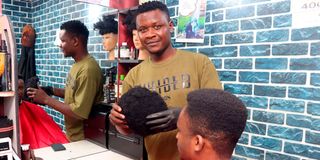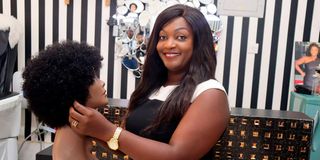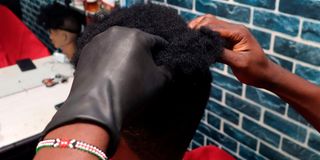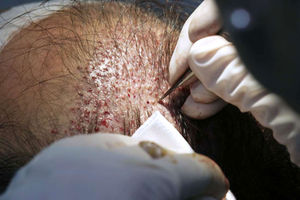
Dominic Musungu, a barber in Nairobi prepares a male wig at his barbershop on February 25, 2025.
For generations, wigs and weaves were a woman’s secret weapon — a quick fix to cover bald patches or switch up hairstyles.
Men, on the other hand, had fewer choices. A receding hairline meant either embracing the bald look or hiding under a cap.
But today, Kenyan men are taking back control of their hairlines — not just with hats, but with man weaves(also known as cranial prosthesis),hair transplants, and scalp micropigmentation, a cosmetic tattoo that mimics hair follicles.
Men are booking three-hour appointments in salons and barbershops to fix hair extensions; some are buying olive oil to keep the wigs and weaves shiny and bonnets to protect the fake hair at night or when showering.
“The man weaves are not just wigs placed on top of the head,” says Diana Akech, a hairdresser and owner at Dee’s Hair and Beauty shop in Nairobi, who was among the first saloons in Kenya to start fixing man weaves.

Dee's Hair and Beauty Salon owner Diana Akech at her Spa in Nairobi on April 14, 2025.
“We use glue to fix synthetic hair pieces to the scalp and blend them into the man’s remaining natural hair. Depending on the type of weave a man chooses, he can wash or brush it. They last two to six months, but some are short-term and cannot be brushed or combed. We encourage the men to sleep with a bonnet or durag and refrain from using oil to make them last longer.”
Over the years demand has grown, and barbers have now started selling man hair extensions, made from human or synthetic hair.
Many men battle hair loss due to genetics, Ms Akech says. Studies have shown that 30-50 percent of men are affected by androgenetic alopecia, the most common form of hair loss in men.
“There are different types of alopecia that men deal with,” Ms Akech says. “Most of the guys that come to me have alopecia areata, usually located in the crown area or different sporadic spots on the head.”
Ms Akech says that compared to when she started, she has seen a big shift.
“For too long, men were boxed into narrow definitions of masculinity that didn’t allow for self-care. Salons have now created a space where men can pamper themselves without judgment. Imagine a man walking into a room filled with 10 men with nice haircuts, and you’re the only one with a bald head. When a man sees himself with a full head of natural-looking hair, it’s a rebirth,” she says.
Can someone spot the difference? I ask.
“Luckily, the man wigs have also come at a time when there have been improvements in the adhesive used to attach the wigs to the scalp, so if you see one up close, they might look a bit scary at first, but once they are styled and cut to shape, they’re amazing,” Ms Akech says.
The price?
“I tell my clients the transformation is emotional and psychological, not just physical. Self-care isn’t just for women. The price ranges from Sh5,000 to Sh50,000,” she says.
50 regular clients
Elsewhere, Dominic Musungu is a barber in Nairobi who fixes male wigs. In 2019, Mr Musungu quickly realised the demand for an alternative solution to male baldness.
“I think I was the first person to do men weaves in Nairobi. Even back then, I was employed as a barber, and we were incredibly busy because men were eager to try the wigs,” he says.
However, the Covid-19 pandemic presented significant challenges as access to wigs and adhesives became difficult.
“The business slowed down because sourcing for wigs became an issue,” he explains.
Having seen potential in the men’s wig business, he opened his salon in 2020.
“Initially, I struggled to find the right glue and materials. The wigs would fade or fall off, and customers complained. But after research and trial, I found a solution that lasts much longer,” he says of his current wigs that can last up to a year.
He says he has now built a loyal client base that extends beyond Kenya.
“The stigma around hair loss has reduced, and wigs are becoming a normal solution. I have over 50 regular clients and many more walk-ins who come after seeing my work on TikTok or hearing about me through word of mouth. Some come from Tanzania, Mombasa, and as far as Zambia,” he says.
Mr Musungu explains that many of his customers return every three weeks to a month for a retouch.

Dominic Musungu, a barber in Nairobi, fits a wig on a customer in his barbershop on February 25, 2025.
“I can get over 100 retouch clients monthly,” he adds, highlighting the growing demand for maintenance services.
The cost?
“It depends on the type of wig and how long it will last on a man’s head. For men’s wigs, prices range from Sh6,000 to Sh45,000,” he tells Nation Lifestyle.
While the male wig business is booming, it has not been without challenges.
“Getting high-quality adhesive to stick on the scalp is not easy. I use various tapes, like super tape and ghost tape, to make sure the wigs stay in place. I also install a scar protector before placing the wig to protect the client's scalp,” Mr Musungu says.
Scalp micropigmentation
Christine Karanja, a permanent makeup artiste and the lead scalp micropigmentation artiste at Sculpted.ke in Nairobi has also joined the men’s hair business.

Christine Karanja, a Scalp Micropigmentation artist at Primp and Coddle Aesthetic Spa in Westlands, Nairobi, on February 25, 2025.
Operating from Nairobi’s Westlands under Primp & Coddle, Ms Karanja and her team cater to Kenyans looking to disguise their hair problems.
She began her career in creating semi-permanent eyebrow tattoos. As more people sought quick beauty fixes, she trained in South Africa and honed her skills in cosmetic tattooing.
“Women wanted a made-up look without spending 30 minutes every morning doing their brows,” she explains. “But then there are these men struggling with baldness.”
By 2021, Ms Karanja had expanded her expertise to include scalp micropigmentation, a procedure that replicates natural hair follicles using specialised ink pigments.
“With men, it wasn’t about brows, but rather the scalp. Baldness is something many men struggle with, and there were few solutions available in Kenya,” she says.
After receiving virtual training from a school in Canada, she transitioned into scalp micro pigmentation.
Unlike traditional hair restoration techniques like transplants or wigs, Ms Karanja creates the illusion of hair density and fullness by carefully tattooing tiny dots on the scalp to mimic hair follicles. The process lasts between one and three hours, depending on the extent of the balding or thinning.
“We’re not trying to grow your hair back. It’s more about camouflaging the thinning areas so it looks seamless with your remaining hair,” she says.
It also involves multiple sessions to achieve the desired look. “We can’t place all the dots in one go, as the pigment may bleed under the skin. It’s important to let the skin heal between sessions,” she explains.
Sh15,000 to Sh40,000
The process, which costs between Sh15,000 to Sh40,000 also involves consultation.
“For example, people with skin conditions like keloids or uncontrolled diabetes may not be ideal candidates for scalp micro pigmentation. If you have conditions like skin cancer or severe dandruff, you’ll need to wait until your skin is healed before undergoing the treatment,” she adds.
As more Kenyans become aware of adding colour to the scalp to create an illusion of a full head, Ms Karanja says she has seen a steady increase in clientele.
“Initially, people were sceptical, especially since it was relatively new in Kenya. Many Kenyans go for hair transplants in Turkey, but sometimes the results are patchy or not successful. They come back to fill those areas with scalp micro pigmentation,” she says.










